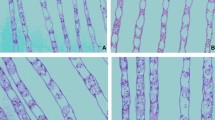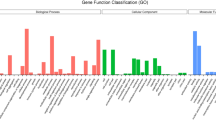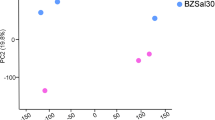Abstract
Salinity is an important abiotic stress that affects metabolic and physiological activities, breed, development, and growth of marine fish. Studies have shown that cobia (Rachycentron canadum), a euryhaline marine teleost fish, possesses the ability of rapid and effective hyper/hypo iono- and osmoregulation. However, genomic studies on this species are lacking and it has not been studied at the transcriptome level to identify the genes responsible for salinity regulation, which affects the understanding of the fundamental mechanism underlying adaptation to fluctuations in salinity. To describe the molecular response of cobia to different salinity levels, we used RNA-seq analysis to identify genes and biological processes involved in response to salinity changes. In the present study, 395,080,114 clean reads were generated and then assembled into 65,318 unigenes with an N50 size of 2758 bp. There were 20,671 significantly differentially expressed genes (DEGs) including 8805 genes adapted to hypo-salinity and 11,866 genes adapted to hyper-salinity. These DEGs were highly represented in steroid biosynthesis, unsaturated fatty acid metabolism, glutathione metabolism, energy metabolism, osmoregulation, and immune response. The candidate genes identified in cobia provide valuable information for studying the molecular mechanism of salinity adaptation in marine fish. Furthermore, the transcriptomic sequencing data acts not only as an important resource for the identification of novel genes but also for further investigations regarding cobia biology.






Similar content being viewed by others
Abbreviations
- bp:
-
base pairs (measuring unit)
- DEGs:
-
differential expressed genes
- RPKM:
-
reads per kb per million reads
- FDR:
-
false discovery rate
- GO:
-
gene ontology
- KEGG:
-
Kyoto Encyclopedia of Genes and Genomes
- NCBI:
-
National Center for Biotechnology Information
- RPKM:
-
reads per kilobase per million reads
- RNA-seq:
-
RNA-sequencing
- Ebp:
-
emopamil binding protein;
- CS:
-
citrate synthase
- IDH:
-
isocitrate dehydrogenase
- LDH:
-
lactate dehydrogenase
References
Alfieri RR, Petronini PG (2007) Hyperosmotic stress response: comparison with other cellular stresses. Pflugers Arch - Eur J Physiol 454(2):173–185
Alina SR, Gráinne K, Martin C, Ruskin HJ (2012) RNA-Seq vs dual- and single-channel microarray data: sensitivity analysis for differential expression and clustering. PLoS One 7(12):e50986
Ana C, Stefan GT, Juan Miguel GG, Javier T, Manuel T, Montserrat R (2005) Blast2GO: a universal tool for annotation, visualization and analysis in functional genomics research. Bioinformatics 21(18):3674–3676
Arnold CR, Kaiser JB, Holt GJ (2010) Spawning of cobia Rachycentron canadum in captivity. J World Aquacult Soc 33(2):205–208
Bayly IAE Salinity tolerance and osmotic behavior of animals in athalassic saline and marine hypersaline waters. Annu Rev Ecol Syst
Calvanese L, Pellegrini-Calace M, Oliva R (2013) In silico study of human aquaporin AQP11 and AQP12 channels. Protein Sci 22(4):455–466
Campbell EM, Ball A, Hoppler S, Bowman AS (2008) Invertebrate aquaporins: a review. J Comp Physiol B 178(8):935–955
Chong-Robles J, Charmantier G, Boulo V, Lizárraga-Valdéz J, Enríquez-Paredes LM, Giffard-Mena I (2014) Osmoregulation pattern and salinity tolerance of the white shrimp Litopenaeus vannamei (Boone, 1931) during post-embryonic development. Aquaculture 422-423(4):261–267
Chou RL, Su MS, Chen HY (2001) Optimal dietary protein and lipid levels for juvenile cobia (Rachycentron canadum). Aquaculture 193(1):81–89
Coady MJ, Wallendorff B, Gagnon DG, Lapointe JY (2002) Identification of a novel Na+/myo-inositol cotransporter. J Biol Chem 277(38):35219–35224
Denson MR, Stuart KR, Smith TIJ, Weirlch CR, Segars A (2003) Effects of salinity on growth, survival, and selected hematological parameters of juvenile cobia Rachycentron canadum. J World Aquacult Soc 34(4):496–504
Doi AS, Barbieri E (2012) Acute toxicity of ammonia on juvenile cobia (Rachycentron canadum, Linnaeus, 1766) according to the salinity. Aquac Int 20(2):373–382
Du F, Wu Y, Zhang L, Li XW, Zhao XY, Wang WH, Gao ZS, Xia YP (2014) De novo assembled transcriptome analysis and SSR marker development of a mixture of six tissues from Lilium oriental hybrid ‘Sorbonne’. Plant Mol Biol Report 33(2):281–293
Duncan RE, Eszter SN, Kathy J, Maryam A, Hei Sook S (2008) Identification and functional characterization of adipose-specific phospholipase A2 (AdPLA). J Biol Chem 283(37):25428–25436
Faulk CK, Holt GJ (2006) Responses of cobia Rachycentron canadum larvae to abrupt or gradual changes in salinity. Aquaculture 254(1–4):275–283
Gibbons TC, Metzger DC, Healy TM, Schulte PM (2017) Gene expression plasticity in response to salinity acclimation in threespine stickleback ecotypes from different salinity habitats. Mol Ecol 26(10)
Grabherr MG, Haas BJ, Moran Y, Levin JZ, Thompson DA, Ido A, Xian A, Lin F, Raktima R, Qiandong Z (2011) Full-length transcriptome assembly from RNA-Seq data without a reference genome. Nat Biotechnol 29(7):644–652
Guo B, Tang Z, Wu C, Xu K, Qi P Transcriptomic analysis reveal an efficient osmoregulatory system in Siberian sturgeon Acipenser baeri in response to salinity stress. Sci Rep
Halestrap AP (2013) Monocarboxylic acid transport. Compr Physiol 3(4):1611–1643
Higashimoto Y, Nakao N, Ohkubo T, Tanaka M, Nakashima K (2001) Structure and tissue distribution of prolactin receptor mRNA in Japanese flounder (Paralichtys olivaceus): conserved and preferential expression in osmoregulatory organs. Gen Comp Endocrinol 123(2):170–179
Ho SN (2010) Intracellular water homeostasis and the mammalian cellular osmotic stress response. J Cell Physiol 206(1):9–15
Hosoi M, Shinzato C, Takagi M, Hosoi-Tanabe S, Sawada H, Terasawa E, Toyohara H (2010) Taurine transporter from the giant Pacific oyster Crassostrea gigas : function and expression in response to hyper- and hypo-osmotic stress. Fish Sci 73(2):385–394
Hwang PP, Lee TH (2007) New insights into fish ion regulation and mitochondrion-rich cells. Comp Biochem Physiol A Mol Integr Physiol 148(3):479–497
Jia Y, Lin F, Hongkun Z, Yong Z, Jie C, Zengjin Z, Jing W, Shengting L, Ruiqiang L, Lars B (2006) WEGO: a web tool for plotting GO annotations. Nucl Acids Res 34(Web Server issue):W293–W297
Koteliansky V, Lee A-H, Glimcher LH, Hur KY, So J-S et al (2012) Silencing of lipid metabolism genes through ire1α-mediated Mrna decay lowers plasma lipids in mice. Cell Metab 16(4):487–499
Lai KP, Li JW, Wang SY, Chiu MY, Tse A, Lau K, Si L, Au WT, Tse KF, Wong KC (2015) Tissue-specific transcriptome assemblies of the marine medaka Oryzias melastigma and comparative analysis with the freshwater medaka Oryzias latipes. BMC Genomics 16(1):135
Li R, Yu C, Li Y, Lam TW, Yiu SM, Kristiansen K, Wang J (2009) SOAP2: an improved ultrafast tool for short read alignment. Bioinformatics 25(15):1966–1967
Masamrekh R, Kuzikov A, Veselovsky A, Toropygin I, Shkel T, Strushkevich N, Gilep A, Usanov S, Archakov A, Shumyantseva V (2018) Interaction of 17α-hydroxylase, 17(20)-lyase (CYP17A1) inhibitors - abiraterone and galeterone - with human sterol 14α-demethylase (CYP51A1). J Inorg Biochem S0162013417308334
Mortazavi A, Williams BA, Mccue K, Schaeffer L, Wold B Mapping and quantifying mammalian transcriptomes by RNA-Seq. Nat Methods
Nguyen TV, Jung H, Nguyen TM, Hurwood D, Mather P (2016) Evaluation of potential candidate genes involved in salinity tolerance in striped catfish ( Pangasianodon hypophthalmus ) using an RNA-Seq approach. Mar Genomics 25:75–88
Pilloff D, Dabovic K, Romanowski MJ, Bonanno JB, Doherty M, Burley SK, Leyh TS (2003) The kinetic mechanism of phosphomevalonate kinase. J Biol Chem 278(7):4510–4515
Ricardo LS, James Tony L, Zelionara Pereira B, Adalto B, Nery LEM (2003) Lipids as energy source during salinity acclimation in the euryhaline crab Chasmagnathus granulata dana, 1851 (crustacea-grapsidae). J Exp Zool A Comp Exp Biol 295A(2):200–205
Ronkin D, Seroussi E, Nitzan T, Doron-Faigenboim A, Cnaani A (2015) Intestinal transcriptome analysis revealed differential salinity adaptation between two tilapiine species. Comp Biochem Physiol D: Genom Proteomics 13:35–43
Scarborough PE, Ma J, Qu W, Zeldin DC (1999) P450 subfamily CYP2J and their role in the bioactivation of arachidonic acid in extrahepatic tissues*. Drug Metab Rev 31(1):205–234
Si Y, Wen H, Li Y, He F, Li J, Li S, He H (2018) Liver transcriptome analysis reveals extensive transcriptional plasticity during acclimation to low salinity in Cynoglossus semilaevis. BMC Genomics 19(1):464
Silve S, Dupuy PH, Labit-Lebouteiller C, Kaghad M, Chalon P, Rahier A, Taton M, Lupker J, Shire D, Loison G (1996) Emopamil-binding protein, a mammalian protein that binds a series of structurally diverse neuroprotective agents, exhibits delta8-delta7 sterol isomerase activity in yeast. J Biol Chem 271(37):22434–22440
Thanh NM, Jung H, Lyons RE, Njaci I, Yoon BH, Chand V, Tuan NV, Thu VTM, Mather P (2015) Optimizing de novo transcriptome assembly and extending genomic resources for striped catfish (Pangasianodon hypophthalmus). Mar Genomics 23:87–97
Toru U, Ikuyo I, Nozomu K, Asuka I, Kazuhito T, Xing-Hua J, Nobukazu A, Junken A, Hiroyuki A, Natsuo U (2012) Regulation of peroxisomal lipid metabolism by catalytic activity of tumor suppressor H-rev107. J Biol Chem 287(4):2706
Tseng YC, Hwang PP (2008) Some insights into energy metabolism for osmoregulation in fish ☆. Comp Biochem Physiol Toxicol Pharmacol 148(4):419–429
Wang Z, Gerstein M, Snyder M RNA-Seq: a revolutionary tool for transcriptomics. Nat Rev Genet 10(1):57–63
Wong KS, Ozaki H, Suzuki Y, Iwasaki W, Takei Y (2014) Discovery of osmotic sensitive transcription factors in fish intestine via a transcriptomic approach. BMC Genomics 15(1):1134
Wu Z, Gu B, Wang Z, Chen G (2009) Effects of salinity on growth and energy budget of juvenile cobia, Rachycentron canadum. J World Aquacult Soc 40(3):374–382
Xu Z, Gan L, Li T, Xu C, Chen K, Wang X, Qin JG, Chen L, Li E (2015) Transcriptome profiling and molecular pathway analysis of genes in association with salinity adaptation in Nile Tilapia Oreochromis niloticus. PLoS One 10(8):e0136506
Yang Y, Cheng JZ, Singhal SS, Saini M, Pandya U, Awasthi S, Awasthi YC (2001) Role of glutathione S-transferases in protection against lipid peroxidation. Overexpression of hGSTA2-2 in K562 cells protects against hydrogen peroxide-induced apoptosis and inhibits JNK and caspase 3 activation. J Biol Chem 276(22):19220–19230
Yau-Chung H, Chao-Kai K, Cheng-Hao T, Tsung-Han L (2015) Transcriptomic analysis of metabolic pathways in milkfish that respond to salinity and temperature changes. PLoS One 10(8):e0134959
Yi B, Qianfeng Z, Guofang Z (2014) RNA-Seq technology and its application in fish transcriptomics. Omics J Integr Biol 18(2):98
Yoshida Y, Aoyama Y, Noshiro M, Gotoh O (2000) Sterol 14-demethylase P450 (CYP51) provides a breakthrough for the discussion on the evolution of cytochrome P450 gene superfamily. Biochem Biophys Res Commun 273(3):799–804
Zhang X, Wen H, Wang H, Ren Y, Zhao J, Li Y (2017) RNA-Seq analysis of salinity stress-responsive transcriptome in the liver of spotted sea bass (Lateolabrax maculatus). PLoS One 12(3):e0173238
Acknowledgments
The authors are grateful to the GENE DENOVO Biotechnology Limited Company that offered facilities and technical assistance to run the ion proton sequencer. We also thank the anonymous reviewers for their critical comments.
Availability of data and materials
The RNA sequence data supporting the conclusions of this article are available in the National Center for Biotechnology Information (NCBI) Sequence Read Archive (SRA): SRP202920, https://submit.ncbi.nlm.nih.gov/?logout_from=%2Fsubs%2F.
Funding
This work was supported by the China Agriculture Research System (CARS-47). The funding bodies were not involved in the design of the study and collection, analysis, and writing of the manuscript, but provided financial support to cover the costs of the bioassays and sequencing.
Author information
Authors and Affiliations
Contributions
ZW, GC, JZ, CP, JH, HZ, and QM designed the experiments. DC, JL, and BH conducted the experiments. DC and ZW prepared the manuscript. All authors read and approved the final manuscript.
Corresponding author
Ethics declarations
Conflict of interest
The authors declare that there are no conflicts of interest.
Ethics approval and consent to participate
All animal experiments were conducted in accordance with the guidelines and approval of the respective Animal Research and Ethics Committees of Guangdong Ocean University. The field studies did not involve endangered or protected species.
Additional information
Publisher’s note
Springer Nature remains neutral with regard to jurisdictional claims in published maps and institutional affiliations.
Electronic supplementary material
Additional file 1
S1 Appendix. The primers designed for real-time PCR validation (DOT 32 kb)
Additional file 2
S2 Appendix. List of KEGG pathway analyzed in cobia (XLS 470 kb)
Rights and permissions
About this article
Cite this article
Cao, D., Li, J., Huang, B. et al. RNA-seq analysis reveals divergent adaptive response to hyper- and hypo-salinity in cobia, Rachycentron canadum. Fish Physiol Biochem 46, 1713–1727 (2020). https://doi.org/10.1007/s10695-020-00823-7
Received:
Accepted:
Published:
Issue Date:
DOI: https://doi.org/10.1007/s10695-020-00823-7




